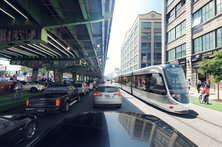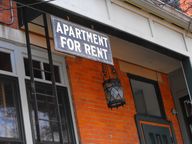 Brooklyn Streetcar; Image by Friends of the Brooklyn Queens Connector Brooklyn Streetcar; Image by Friends of the Brooklyn Queens Connector In his recent state of the city address, New York City mayor Bill de Blasio talked about a lot, but might have made the biggest impression on listeners when he endorsed the idea of a new Brooklyn-Queens Connector. This grade-level streetcar project would run 16 miles along the East River and be funded by tax increment financing. For many onlookers, including the New York Times, it was surprising to hear a mega-project be a top priority of the likes of de Blasio and it immediately raised concerns about the pitfalls of grand infrastructure projects. For Mr. de Blasio, a Democrat focused on social reform, the plan also represents a shift to the kind of ambitious Robert Moses-style planning that New Yorkers more often associate with his predecessor, former Mayor Michael R. Bloomberg, who made transportation a hallmark of his tenure. (Wow, de Blasio drew a Robert Moses comparison? Nobody would have predicted that when he was elected!)
As CityLab's headline suggested ("New York Has a Streetcar Plan that Isn't Totally Awful"), the perception of the project is that, if done well, it could be very beneficial for the community and a wise investment. High on the list of factors contributing to skepticism about the project is the value capture aspect of the proposal. There has been recent value capture backlash in New York City due to issues with TIF in similar transit-related circumstances, including the modest - relative to initial promises - portion of capital costs that value capture covered on the downsized transit project at Hudson Yards. There's always the problem with mega-project cost increases and budget overruns, but concerns around value capture often focus on its modest or unpredictable funding capacity. It is true that, depending on its format, value capture can be an unpredictable or volatile funding source. Tax increment financing relies on increased property taxes in an area and, depending on the local property assessment regime, property taxes can produce volatile revenue streams. And, if increment projections rely heavily on new development, then future revenues can be as unpredictable as future market cycles. When such volatility exists, politicians must consider who backstops the bond repayments. If the Brooklyn and Queens neighborhoods around the proposed Connector do not experience significant value increases in the future and value capture yields fall short of expectations, will the City of New York help fund the bond payments (a general obligation guarantee)? If not the City, are there other reputable funding sources (according to bond underwriters) that can backstop transit construction and operations costs? Like any funding mechanism (consider sales tax-funded transit programs like Denver's FastTracks!), transit value capture poses financial risks and, therefore, political risks. Robust forecasts of value capture revenues can help politicians like Bill de Blasio confidently stride to the podium and announce that a new transit project is forthcoming. Let's hope de Blasio's advisors got the projections right for the Brooklyn-Queens Connector!
0 Comments
 Image by the cincy Project Image by the cincy Project It's well appreciated that transit service can contribute to real estate value, both the value of existing property improvements and land. For now, let's consider how transit impacts the operations of an existing building from the real estate asset manager's perspective. Here's an incomplete list of potential costs and benefits:
An illustration of value creationNow, let's assume that a transit improvement has been made near a property and the building's asset manager is in the process of producing the latest monthly performance summary for their oversight committee. What tangible impacts could transit services have on the top line, the cost line, and, therefore, the bottom line that will appear in this report?
Here's a fictionalized tale of transit's impacts on a mixed-use building at 1001 Main Street: 1001 Main Street was a middling asset in the mixed-use property portfolio of a regional investment fund. The introduction of transit offered a glimmer of hope for the property's asset manager and he looked forward to comparing the pre- and post-transit performance of 1001 Main Street. The introduction of transit in the vicinity wasn't all bells and whistles. There were both costs and benefits for the property. For example, transit-related construction had an impact on the operations of the building. Recognizing that the construction was causing inconveniences, the building manager offered more perks to existing tenants to compensate. Even so, two tenants decided to move due to the construction and one retailer went out of business because of the lack of foot traffic. The vacancies were difficult to fill because fewer people wanted to visit the available spaces. Also, the leasing team spent more per lead luring each potential tenants to the property. Management decided to forgo revenue rather than accept lower long-term lease rates during the temporary construction period. There were additional costs associated with cleaning and maintenance due to construction debris. Capital costs were incurred to add a new dust filtration unit to the ventilation system on the lower floors. After the completion of construction, transit had more positive than negative impacts on 1001 Main Street. For one, ground floor retailers have seen a rebound in foot traffic. As more people pass by storefronts, sales have increased. The two restaurants have had to adopt reservation policies due to increased interest. A cafe space, one of the vacancies that arose during the transit construction, leased for twice what it was garnering prior to transit. It is anticipated that the other retail leases will be renewed at the higher rates. In addition, there have been more eyeballs on the building in general and a local advertising company recently approached management about paying for signage space on the outside of the building. This is a completely new revenue source at 1001 Main Street. At times, the increased accessibility of the area has brought large diverse crowds of people to the neighborhood. Some tenants expressed concerned about passerbys using the building's bathrooms and lobby spaces. In response, management decided to contract for an additional front desk security person, an operating cost that offsets some of the higher retail rent revenue. With a new transportation alternative and a appreciable number of tenants using the transit to get to work, management saw an opportunity to raise parking rates without much fuss. Ultimately, the leasing team was able to attract more intensive space users (more people per square foot) because parking demand was lower and there were more vacant parking spaces. One such tenant was a technology company that saw transit access as an important feature for their younger workforce. The new intensive-use tenants pay more per square foot than prior tenants and generate only marginally more wear and tear on the building. Overall, new and renewed office leases at 1001 Main Street were being signed at a higher per-square-foot rate than before the transit improvement. The lease rates were higher than contemporary leases at a sister property, 999 Faar Street, that's farther from transit. In fact, the sister building's leasing team lost several tenants to buildings closer to the transit improvement. In one particular instance, an office tenant at 1001 Main Street decided not to renew their lease. They sited the increase in lease rates and the higher cost of parking as being prohibitive for their clients, most of whom drove to the firm. They decided to move to a more suburban location near 999 Faar Street where their clientele could more easily access their services and rents were lower. While the offices in 1001 Main Street have been leasing for higher rates, noise from transit line has been a deterrent for some firms. It has taken longer to find tenants willing to pay the asking price for units on the transit-facing side of the building. In contrast, absorption on the opposite side of the building has been swift. The hotel has had more bookings from business and leisure travelers, though local hotel stays remained consistent over the period. Conference and event bookings increased both due to greater exposure from people passing through/by the building and due to the increased accessibility of the location. With the new interest in the building, management is considering converting two floors of storage space into leasable guest facilities. The warehousing space was once prized by legal firms and doctors in the neighborhood for file storage but it's now more lucrative to pay for upgrades and redeploy the space in another format. All in all, the asset at 1001 Main Street has experienced benefits that have outweighed the costs. The management team has had to deal with some turnover and change, but have found ways to capitalize on the opportunities. The asset manager is excited to inform investors that increases in the net operating income of the property have increased the value of 1001 Main Street by 20%. In this case, transit has profoundly changed how the building operates. The end. So, can you think of any other potential costs and benefits of transit? Australia seems to have a high-level public discourse on the merits of transit value capture policy. That's a hopeful thing for us since many scholars consider Australia the most comparable society/country to the United States. This opinion piece considers the risks of a transit value capture policy. For example, the author considers the timing of introducing new value capture policies: There is a real risk in Sydney that over-provision of high-rise residential properties will over-saturate the market, producing low returns and low "value uplifts". I look forward to this sort of discussion in our national political forums!
|
AuthorIan Carlton is a transportation and land use expert specializing in transit-oriented development (TOD). He helps clients - including transit agencies, planning departments, and landowners - optimize real estate development around transit. Archives
March 2019
CategoriesSpecial thanks to Burt Gregory at Mithun for permission to use the Portland Streetcar image above.
|
Photo from permanently scatterbrained
 RSS Feed
RSS Feed

